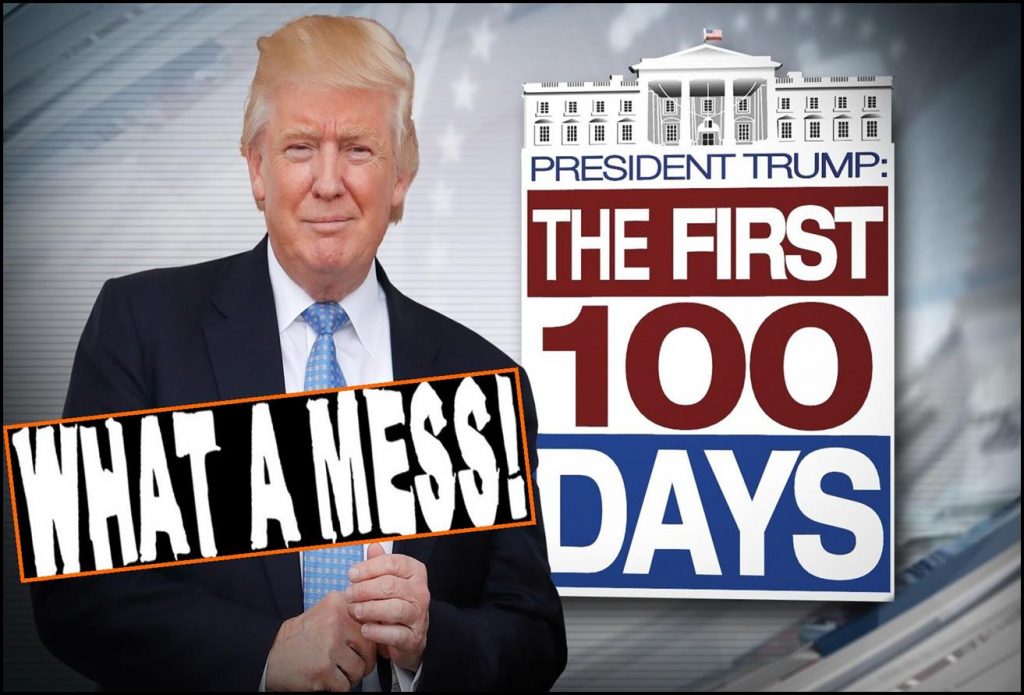Trump’s 100 days, a mess in Congress
Congress is entering a critical juncture which could determine the fate of many of their legislative priorities for the year. In addition to the obvious looming issues of keeping the government open, ObamaCare repeal, tax reform, and Dodd-Frank reform, Congress will address spending bills and will be forced to deal with the looming debt limit this fall. In short, the grace period (if there ever was one), is over.
There is little doubt that the Democratic base is energized. Recent special elections in Kansas and Georgia, where a first-time Democratic candidate raised an extraordinary $8 million (and growing), has put Republicans on notice that 2018 will not be a cake-walk. However, despite the heat and rhetoric of potential Democrats gains, so far, they have not materialized. National media attention aside, Democrats are in desperate need of a win following the disastrous 2014 and 2016 election cycles. Legislatively, Republicans have provided little for their base to be excited about. Failure to deliver on big ticket items will do more damage to the GOP than anything their Democratic counterparts can accomplish. To achieve large legislative victories, the White House and Republicans in Congress must start reading from the same playbook soon.
POLITICAL ENVIRONMENT – Love or Poison?
Democratic opposition to Trump has so far been tethered to politically-charged issues such as the release of Trump’s tax returns and, of course, claims that Russia and Trump colluded to win the election. We have even seen Rep. Maxine Waters (D-CA) mention impeachment, which has catapulted Waters to the forefront of progressive opposition to the President. These issues certainly play to the core of the Democratic Party, but whether they extend beyond that remains to be seen. Democrats were fixated on Trump’s tax returns and similarly irrelevant issues during the 2016 election and that proved to be a significant political miscalculation.
Read more: MELISSA HODGMAN, Racist SEC Enforcement Staffer Wants Pay Raise, Not the Truth
While House Minority Leader Nancy Pelosi (D-CA) and her allies in the House have the latitude to be the tip of the spear in opposing Trump, her Senate counterpart, Sen. Chuck Schumer (D-NY), must be cognizant of the 2018 political battlefield where nine of his members will be up for re-election in states where Trump won. To date, Sen. Bernie Sanders (I-VT) has been able to exercise greater influence over the Democratic caucus than Schumer. Right now, vulnerable Democratic Senators seem more concerned about covering their left flank than appealing to the moderate middle at home. We have already seen this play out on the nomination of Judge Gorsuch to the Supreme Court. Three Democratic Senators up for re-election in 2018 voted for the Trump nominee to the High Court. One red state Senator who opposed, Sen. Jon Tester (D-MT), now finds himself in the crosshairs of the National Rifle Association. Leader Schumer must find a “Goldilocks” approach to dealing with the president.
LEGISLATIVE CALENDAR – Big Ambition, small steps
The biggest looming issue over the Republican Congress continues to be Obamacare repeal. Negotiations continue behind the scenes with some reports suggesting that a deal between the conservative Freedom Caucus and moderate members of the GOP Conference is imminent. Others are downplaying the progress suggesting more discussions will be needed. While Rep. Mark Meadows (R-NC), Chairman of the conservative Freedom Caucus, and Rep. Tom MacArthur (R-NJ), Co-Chairman of the moderate Tuesday Group, are in discussions, it is unclear if they speak for themselves or their organizations. Assuming Meadows and MacArthur agree on language, work and whipping will need to be done to see if they can bring the actual votes needed to push it over the finish line.
Whether repeal happens or not, there are several pending issues with more limited time available for discussion. The first is the continuing resolution to fund the government, which expires this coming Friday. It appears as though a CR/Omnibus (or Cromnibus) will be the vehicle that funds the government. Look for a few bipartisan-negotiated appropriations bills included in the package and a CR for the remaining bills. Also included will be the plus up for defense via the defense appropriations bill that already passed the House. ObamaCare subsidies in exchange for border wall money is on the table, but that deal will be tough to close. As of this morning, it looks as though the White House is not interested in flirting with a potential shutdown over contentious issues and will likely allow this bipartisan-negotiated vehicle to proceed. There’s a chance this deal comes together last minute, so look for a bridge short-term CR to fund the government into next week.
Read more: Op-Ed: WHEN PROSECUTORS LIE, CHEAT, STEAL, AMERICAN HERO DAVID GANEK FIGHTS BACK FOR ALL AMERICANS
The other critical issue, of course, is tax reform. The stated goal of tax reform has become a moving target. Speaker Paul Ryan (R-WI) and Ways and Means Chairman Kevin Brady (R-TX) have worked diligently to move their revenue-neutral “blueprint,” but recent talk inside the White House is now squarely aimed at reducing the tax burden on individuals and businesses. While this might be an easier sell to the American people and Republicans in the Senate, it remains to be seen if a more deficit-conscious House would be willing to go along with this approach. Additionally, it is important to note major U.S. businesses have been invested in the tax reform debate because a permanent overhaul would provide them with the certainty they need to make long-term decisions and investments. A temporary rate cut, which would be welcomed by many, might not enjoy the same level of support from the business community. Tomorrow, we expect to see a high-level outline or broad set of principles coming from the White House on taxes. Whether its tax reform or tax cuts, some hope this can be accomplished by the August recess. The end of the year is a more likely target.
Trump – Drowned in the DC swamp?
As we have stated before, it is important to keep in mind that the President is not beholden to the same constituencies and interest groups as previous Republican presidents. The President’s unconventional approach was a major asset for Trump the candidate, but from a governing perspective it has led to competing priorities with the more conventional Republicans in Congress. We are now seeing this play out over the government funding and tax reform debates. If and when the White House and Republicans on Capitol Hill begin to utilize more of a hand-in-glove approach, the likelihood for success will increase dramatically. That said, other presidents have had success triangulating Congress, and it seems like Trump could go either way on building a relationship based on trust and party unity.
Below we’ve included additional large ticket items we expect for the remainder of the year:
- Health Care – Renewed push to accomplish ObamaCare repeal and replace in May
- CHOICE Act – Hearing tomorrow, mark-up and floor vote expected in May
- FY18 Budget that provides reconciliation for tax reform
- Flood insurance
- FAA
- SCHIP – Expires this Summer
- Debt limit – Post August Recess
- Fund the government – September
- Infrastructure







One Comment
Leave a Reply